WWII Pictures of the B-24 Witchcraft Throughout Its Career
The B-24 flew in every theater of WWII. There were more than 18,000 of them
produced, more than any other US military aircraft and more than any other multi-engine
bomber of any nation. Witchcraft was a B-24H in the 467th Bombardment Group,
790th Bombardment Squadron of the 8th Air Force. It flew in the 467th BG's first
mission (April 10, 1944), its last mission (April 25, 1945), and 128 missions
in between -- 130 missions in all, an 8th AF record.
The following are pictures of Witchcraft. They are arranged chronologically
as best I can determine. Some pictures have dates written on them. Some do not
but show the number of bomb symbols painted on the side of the aircraft. This
shows approximately how many missions Witchcraft had flown to that point (at
least to within perhaps a few, as the bomb symbols were perhaps not always painted
on immediately after the mission). From the list of mission dates given here
(http://www.467bg.com/witchcraft.html),
that gives a good estimate of date. These images can be found at http://www.467bg.com/witchcraft.html
and http://www.the467tharchive.org/gallerysix.html
, and some are courtesy of Perry Watts (author of The
467th Bombardment Group (H) in World War II: In Combat With the B-24 Liberator
over Europe).
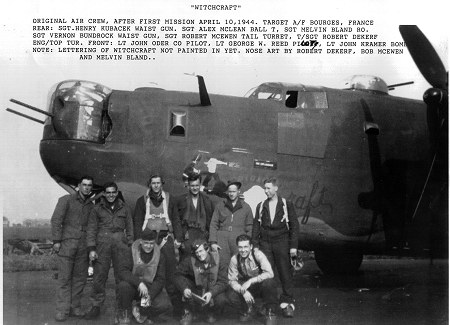
The first crew of Witchcraft after its first mission on April 10, 1944. "Witchcraft"
not painted in yet. Top row, left to right: Henry Kubacek (waist gunner), Alex
McLean (ball turret), Melvin Bland (radio operator), Vernon Bondrock (waist
gunner), Robert McEwen (tail gunner), and Robert DeKerf (engineer/top turret).
Bottom row, left to right: John Oder (co-pilot), George Reed (pilot), and John
Kramer (bombardier).
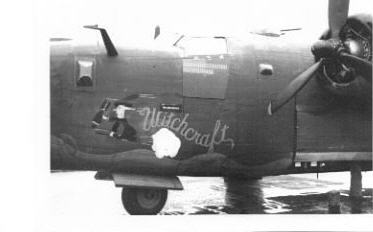
Judging from the bomb symbols, a picture from perhaps about 40 missions.
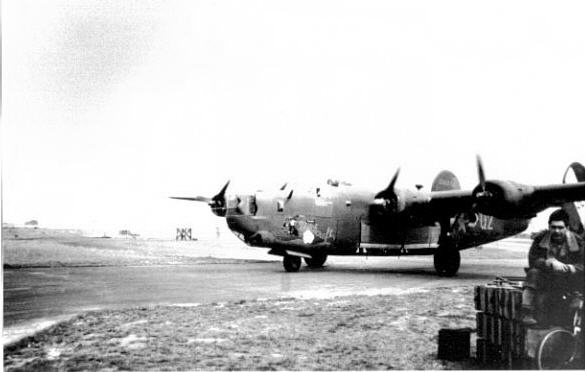
Witchcraft taxiing, judging from the bomb symbols (which seem the same as the
previous picture) from perhaps about 40 missions. Mission 40 occurred July 6,
1944. However, the weather does not look very warm in this picture judging by
the jacket, so perhaps it is a bit earlier than that.
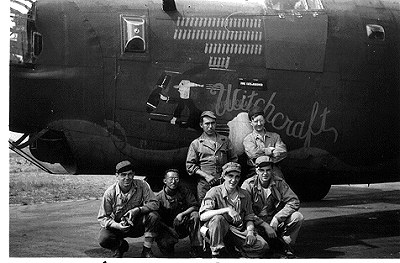
Witchcraft's ground crew, judging from the bomb symbols, pictured sometime after
the 60th mission (August 12, 1944). M/Sgt. Joe R. Ramirez (crew chief); George
Y. Dong (assistant crew chief); Raymond A. Betcher (mechanic); Walter L. Elliott
(mechanic); and Joseph J. Vetter (mechanic).
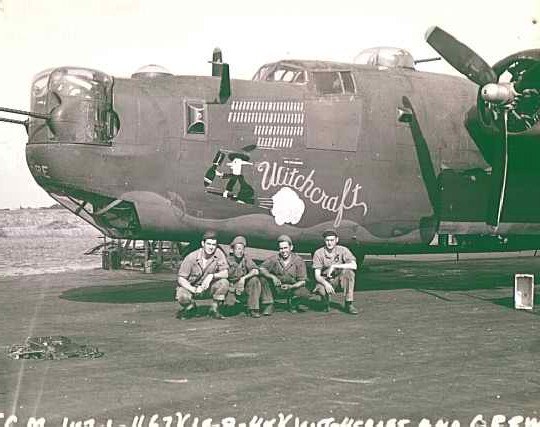
Witchcraft ground crew, judging from bomb symbols, pictured sometime after the
65th mission (August 18, 1944). The white lettering at the bottom of the picture
is cut off but looks somewhat like "16-8-45" although this picture
must be in 1944 sometime.
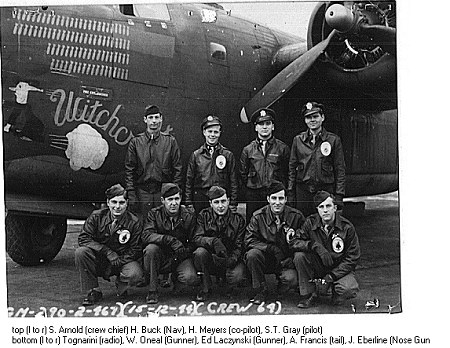
Crew 64. Writing on image indicates it was taken December 15, 1944, thus after
the 93rd mission (although there are 89 bomb symbols). Top row, left to right:
S. Arnold (crew chief), H. Buck (navigator), H. Meyers (co-pilot), and S. T.
Gray (pilot). Bottom row, left to right: Tognarini (radio), W. Oneal (gunner),
Ed Laczynski (gunner), A. Francis (tail gunner), and J. Eberline (nose gunner).
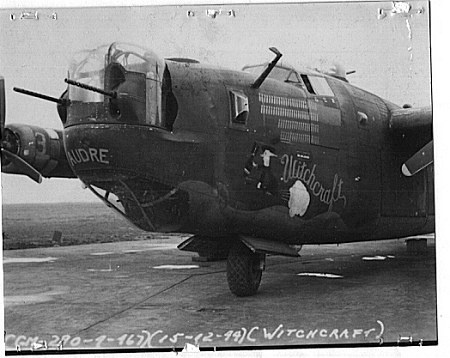
The writing on the picture indicates is was taken December 15th, 1944, thus
after the 93rd mission (although there are 89 bomb symbols).
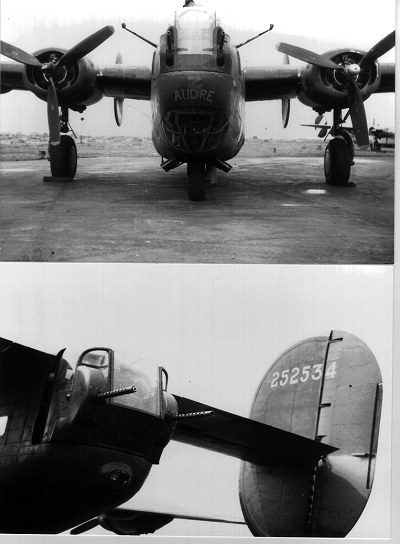
It is unclear when this was taken. The engine cowlings look like they are still
olive drab with gray undersides (so perhaps approximately 100 missions or earlier
as, at some point after 100 missions, Witchcraft picks up different-color cowlings)
and the weather looks like fall or winter. "Audre" on the nose of the
plane is the name of John Kramer's wife.
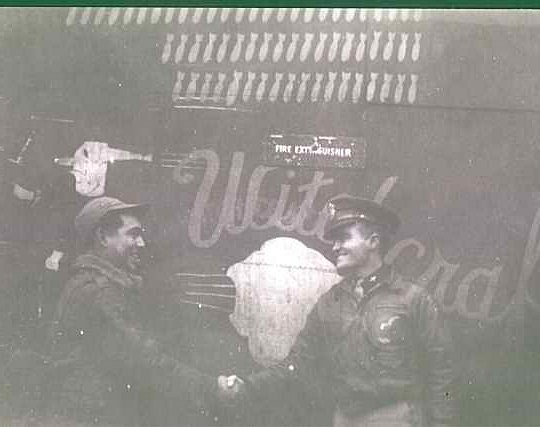
Fred Holdrege (CO of the 790th BS, on the right) shaking hands with Joe Ramirez
(crew chief of Witchcraft, on the left) after the aircraft landed from its 100th
mission.
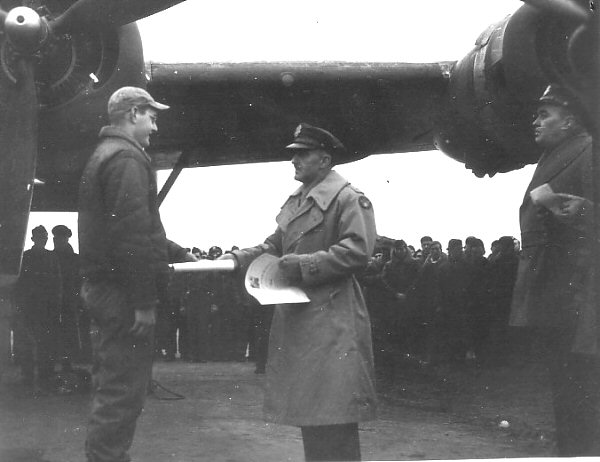
Raymond Betcher (mechanic, left) receiving an award from General Kepner upon
Witchcraft's 100th mission.
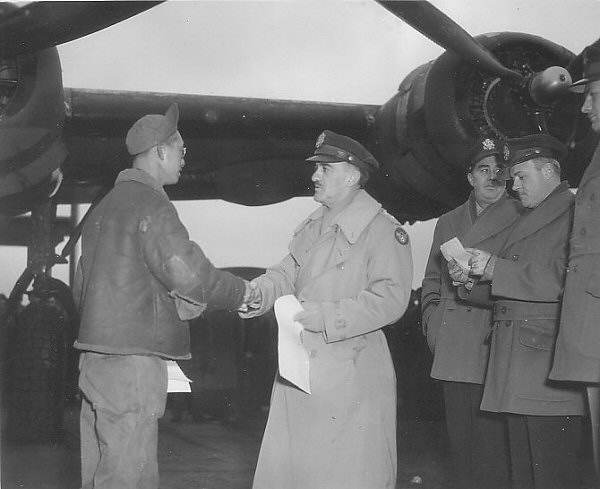
George Dong (assistant crew chief, left) likewise receiving an award from General
Kepner upon Witchcraft's 100th mission.
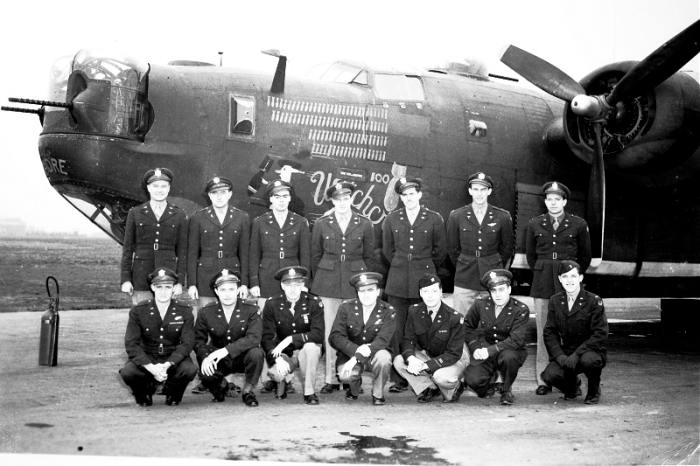
Officers of the Squadron Administration of the 790th Bombardment Squadron around
Witchcraft after its 100th mission. Major Fred Holdrege, the Commanding Officer
of the 790th BS, is in the middle of the front row. There are 98 small bomb
symbols painted, not including the big bomb symbol next to the "100",
denoting 98 missions where bombs were dropped. Prior to this time, there had
been two missions where there was a recall prior to the target, thus 98 bomb-drop
missions and 100 missions total. The 98th mission (not including the two recalls)
occurred on January 7, 1945, and the 100th mission occurred on January 13, 1945.
Video of landing and ceremony after 100th mission (click on image to play video):
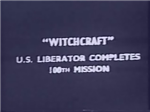
The video is narrated by Fred Holdrege, the Commanding Officer of the 790th Bombardment Squadron.
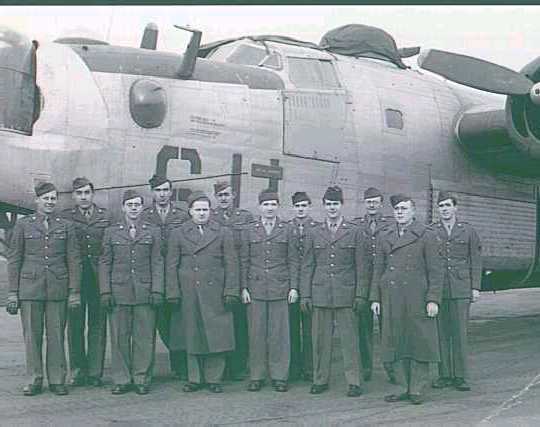
A picture of airmen of the 790th Squadron in front of another B-24 (looks to
be ship #611).

Judging from bomb symbols, picture taken sometime around the 100th mission (January
13, 1945).
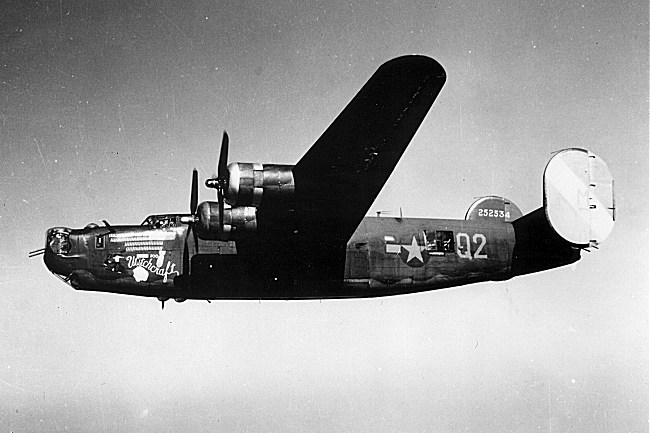
A beautiful picture of Witchcraft in flight, judging from bomb symbols, sometime
well after the 100th mission. There are many more bomb symbols than for the
100-mission Witchcraft. The symbols go farther back than on the 100-mission
Witchcraft -- to the middle of the big bomb-symbol's fins and to the middle
of the pilot's window (past the second white mark under the pilot's window).
This makes it about 110-120 bomb symbols. Also, the engine cowlings and cowl
flaps (which come and go with the engines on replacements) are of mismatched
colors, which did not seem to be the case in the pictures of the 100-mission
Witchcraft.
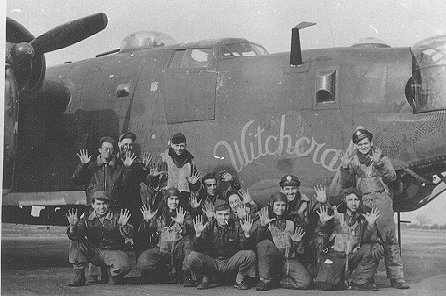
Picture taken after the 120th mission (March 4 or 12, 1945 depending on whether
the two recalls were counted). 12 crew with 10 fingers each.
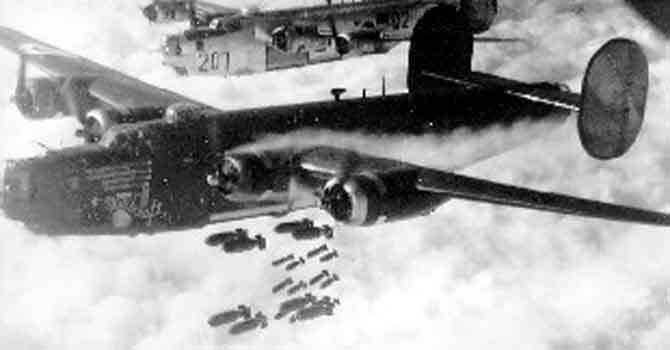
Witchcraft dropping bombs, judging from bomb symbols, sometime well after the
100th mission -- probably later than the 120th mission. In this picture, there
are more bomb symbols than for the picture estimating the total at 110-120 and
just a little less than in the picture below at Willow Run. Also, this picture
has a light (perhaps natural aluminum) color on the cowling for the right, inboard
engine whereas, in the picture indicating mission 120, that particular engine
cowling seems to have a darker coloration (like the rest of the aircraft). This
picture is perhaps thus around 125 missions (March 31, 1945).
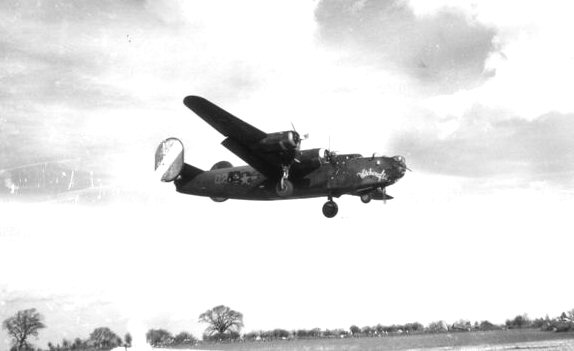
Witchcraft landing at Rackheath, England. Based on the mismatched engine cowlings,
again, I estimate that this is after the 120th mission.
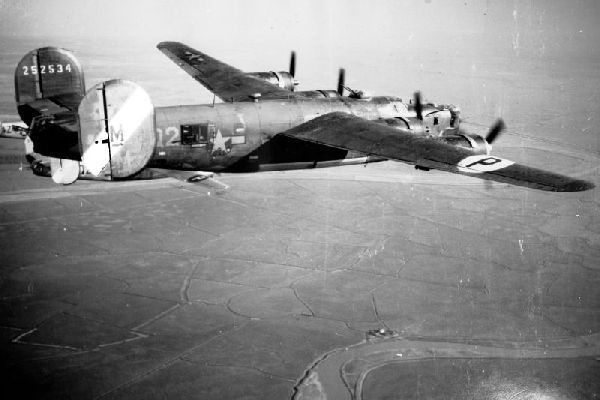
Witchcraft in flight with other B-24's. This has yet a different arrangement
of engine-cowl and cowl-flap colors than the previous pictures. It is unclear
when this picture is taken other than it likely being later than 100 or 120
missions.
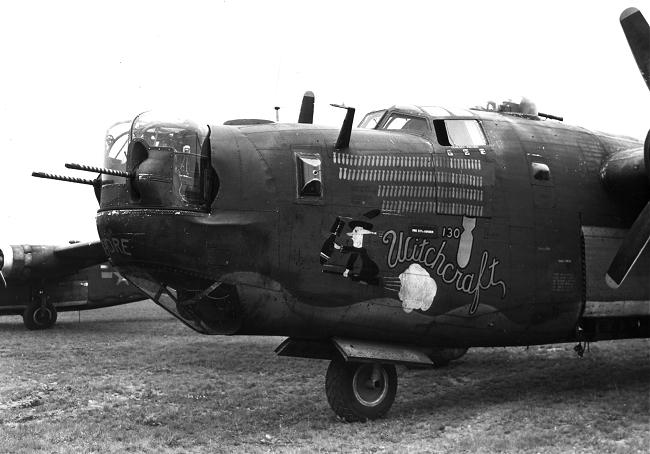
Sometime after the 130th and last mission (April 25th, 1945). Note that "Witchcraft",
the large bomb symbol, and "130" now have outlines painted in black.
This might be at Willow Run airport in Michigan, USA.
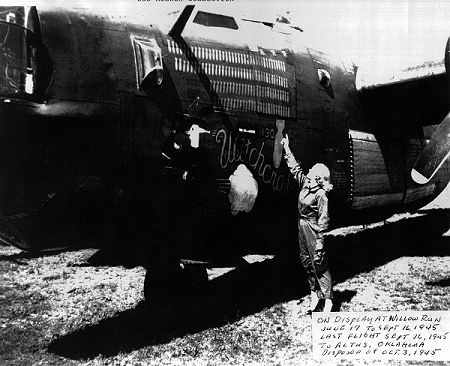
Witchcraft at Willow Run airport in Michigan, USA, sometime around June, 1945.
The WASP pilot (perhaps the one who ferried Witchcraft to Willow Run) is pointing
up at the mission tally.
by Brooke P. Anderson
e-mail: brooke@electraforge.com
Click here to go back to the
main page.





















